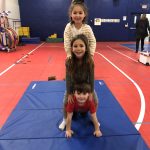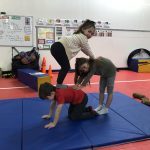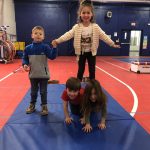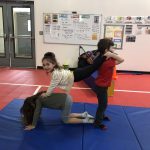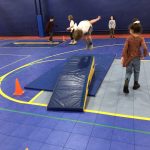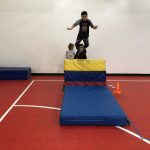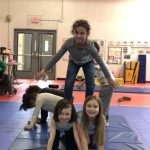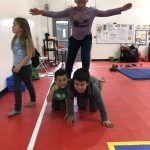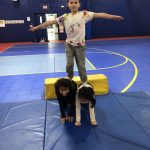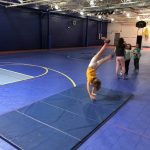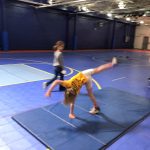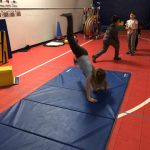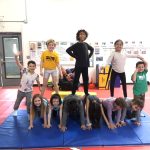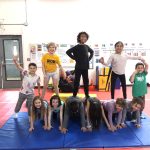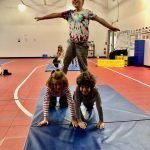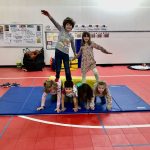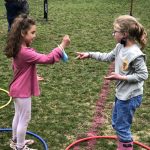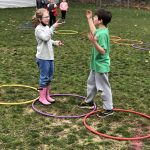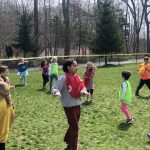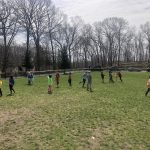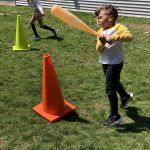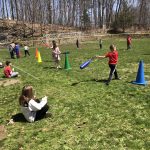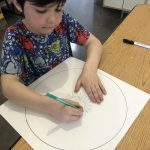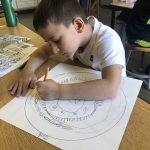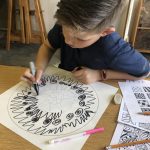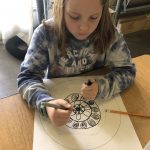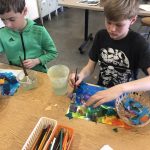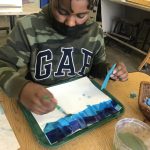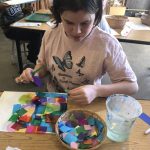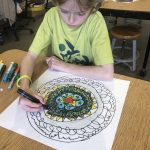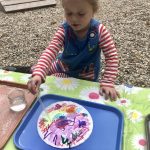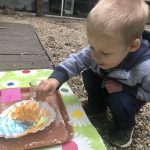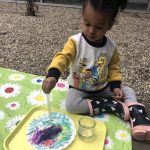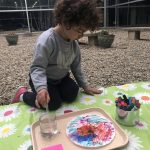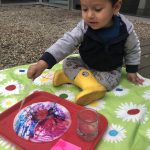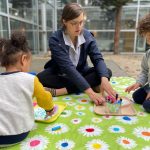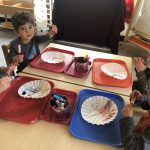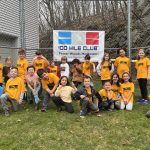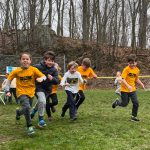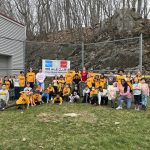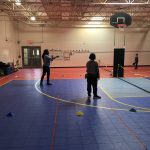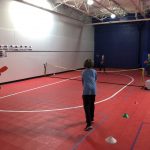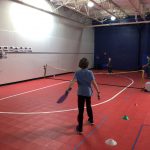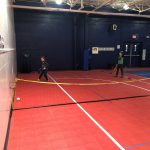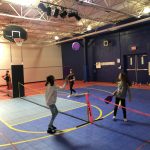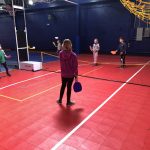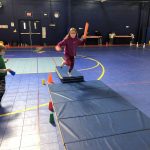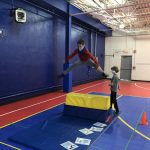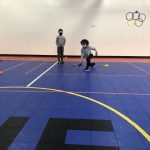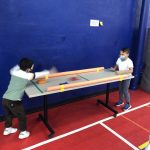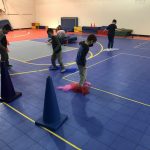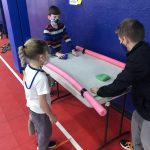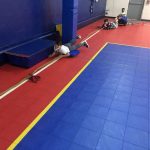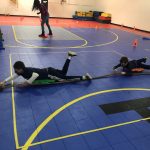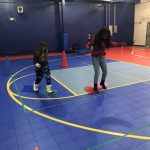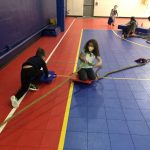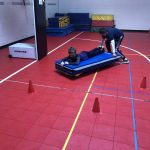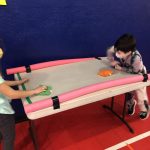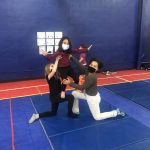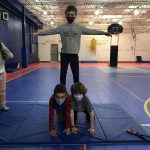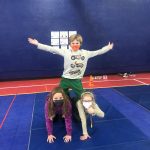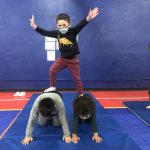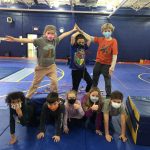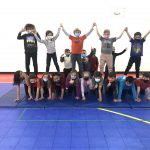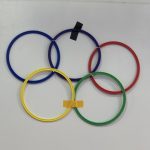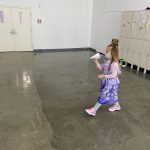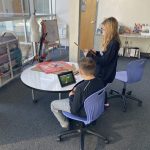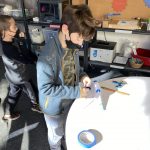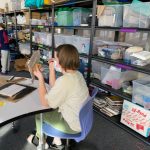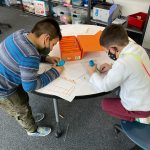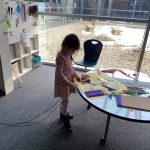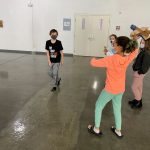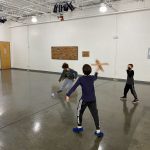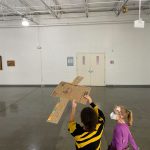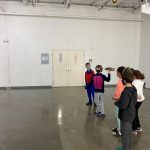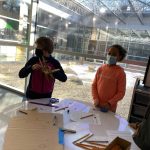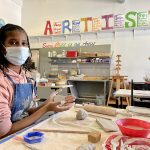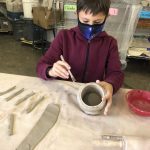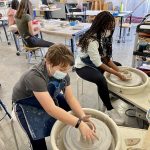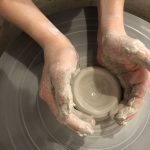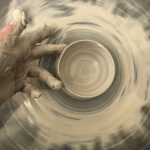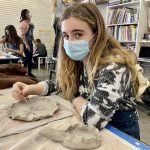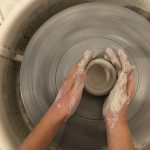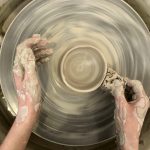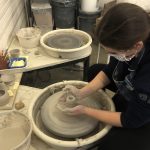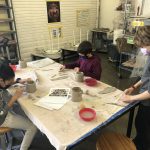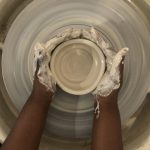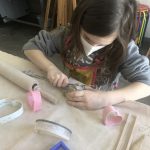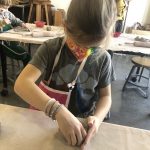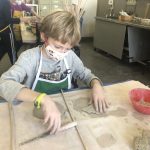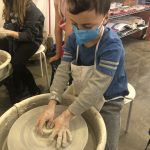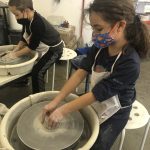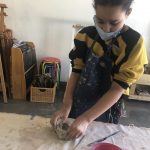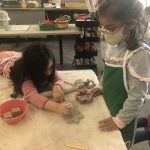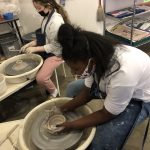The Kindergarten and Lower Elementary students participated in a gymnastics unit where they experienced body weight transfer through floor skills. Students experienced the following apparatus: gymnastic mats for an obstacle course and a balance beam. They also did pyramid building, single balances, and cartwheels. Pyramid building is when a group of gymnasts makes a human pyramid by standing or kneeling on top of one another with only one person on the top level. A human pyramid is a formation of three or more people in which two or more support a tier of higher people. For practical reasons, lighter people are often higher, while stronger/heavier people are closer to the base.
Warm-Up Games & Wiffle Ball in PE!
Lower and Upper Elementary participated in a Wiffle Ball Unit. Students learned how to run the bases and how to hold a wiffle ball. In addition, they learned how to throw and receive a ball, as well as batting off a tee. Students also had a choice for the ball to be pitched to them instead of using the tee. Throwing a ball is not just physical, it is also cognitive. A child has to plan how much force to put into each toss, where to aim to keep the ball from going too high or low, and when to release. The benefits of wiffle ball include: improved balance, coordination, strength and stamina, motor skill development, social skills development, improved self-confidence, and sportsmanship.
Before the start of PE class, students participate in warm-up running games. Some favorites are: Rock, Paper Scissors, Earth Day Tag, Sports Tag, Ice Cream Tag, and Pluck the Turkey. Once a week we run laps for our warm-ups for our 100 Mile Club. Warm-ups in Physical Education prepare the body for movement. A warm-up allows the body to gradually increase its heart rate and body temperature which would reduce the risk of injury.
Art Show on Display!
Students from Toddler through 8th grade have been hard at work creating and finishing up their artwork for our upcoming all-school Art Show! The show will be on display starting Monday May 9th through Friday May 20th. Parents are welcome to come view the exhibition between the hours of 9am-2:30pm. The Art Show will be set up around the walls of our Zen Garden. You will see artwork as you enter, beginning along the walls of Mrs. Semmah and Mrs. Lopes’ classrooms, in the glass display cases in front of the Zen Garden, and continuing through the hallway past Lower Elementary towards the Commons where the show ends.
Putting together an Art Show is an all-encompassing creative experience for our students that addresses many aspects of Art such as; the making of the artwork itself, learning about masterworks, preparing artwork for showcase, titling artwork, collaborating, viewing and interacting with artwork, and understanding art display within an architectural space.
I hope you find a time to visit and see the children’s beautiful works on display! Bravo young artists!
100 Mile Club!
Fraser Woods Montessori was selected to be featured in the 100 Mile Club national newsletter this past month! Be on the lookout for a “save the date” email about the 100 Mile Club Gold Medal Ceremony on the soccer field in June!
Fraser Woods Montessori School and I are very excited to celebrate our 5th year with the 100 Mile Club! FWM is a non-profit school located in Newtown, Connecticut. We offer Montessori education for children in four distinct programs: Toddler, Primary, Elementary, and Middle School. Students have the opportunity to join the 100 Mile Club starting in 1st Grade. Proudly, we currently have 45 participants, which gives us a 90% participation rate for eligible students. When students arrive at school each day, they use the first 30 minutes for running, walking, and playing with friends. Our school is very fortunate to have a designated soccer field on our campus that allows us to track the miles our students run efficiently. All students use the area during our physical education classes, recess, and FWM’s Walking Club. As an advocate for health and wellness, it puts a smile on my face to see students running and truly enjoying exercising. However, I am most happy that each of our youthful participants chooses to live and achieve a healthy lifestyle by participating in physical activity every day, thanks to the 100 Mile Club!
Let’s Play Pickleball!
Pickleball is a paddle sport played with a wiffle ball on a badminton-sized court and a tennis-style net. Pickleball is enjoyed by people of all ages and athletic abilities. Pickleball is played in thousands of school P.E. programs, parks and recreation centers, camps, YMCA’s and retirement communities. This sport is becoming very popular among active senior adults at community centers and is growing in popularity on high school and college campuses.
Pickleball was created during the summer of 1965 in Seattle, WA. The original purpose of the game was to provide a sport for the entire family. Pickles, the family dog would chase after the wiffle balls and then hide in the bushes. The founder suggests that Pickle’s ball was later shortened to Pickleball.
Students in kindergarten through 5th grade participated in a Pickleball unit. Students practiced and participated in demonstrating the proper serve, forehand drive, backhand drive, and abide by rules of fair play. Pickleball helps improve agility, balance, reaction time, and hand-eye coordination. At the end of the unit, students in grades 3-5 participated in a singles and doubles Pickleball tournament. In grades K-2, we modified play by using balloons instead of pickleballs.
Click below to read an article about Pickleball that was published 10 days ago!
https://www.cnn.com/2022/03/20/us/pickleball-explainer-wellness-cec/index.html
Olympic Games in PE!
The Kindergarten, Lower Elementary, and Upper Elementary participated in Winter Olympic Games stations in class. The students were questioned on their knowledge as to why there are only five rings and what the colors represented. They were also asked where the Olympics were taking place and what continent that country was located in. The students participated in the following winter Olympic Game stations: Curling, Speed Skating, Ice Hockey, Table Hockey, Skeleton/Luge, Ski Jump, and Bobsled. The stations they most enjoyed were the bobsled and ski jump!
During our Gymnastics unit, students participated in pyramid building and single balances. A human pyramid is a formation of three or more people in which two or more support a tier of higher people. For practical reasons, lighter people are often positioned higher while stronger/heavier people are located closer to the base.
Makers take flight!
The elementary students have been busy experimenting with the dynamics of flight. Students have been working collaboratively to design and create original flying machines. They are able to use all the tools available to them in the MakerSpace including various recycled materials, laser cut designs, and 3D printing. The students are learning to make calculated design choices in a low risk environment, learning to balance the natural forces around them such as thrust, drag, lift, and gravity. Our makers are given the freedom to discover how their designs react to flight and then encouraged to go back to the drawing board to rebuild based on their observations. Through hands-on experimentation, the students gain confidence in their abilities and a willingness to dive into the unknown. Well done!
The Pottery Wheel and More!
The Art Studio has been buzzing lately with lots of wonderful clay work from students Kindergarten through Middle School! Students have been exploring a range of clay processes and techniques such as coil building, slab rolling, pinching, and throwing on the pottery wheel.
Working with clay has many benefits for children of all ages. It is a complex sensory experience that encourages self-expression, helps promote self-confidence, and develops problem-solving and motor skills. Because clay is highly responsive to touch, children become engrossed in their work: they are able to express and articulate their ideas through shaping clay and learning to repair mistakes. Clay is different from other art mediums in that it requires an understanding of the three dimensional world. While working on their projects, students must move around to see their creation from all sides. From this, they begin to understand shape, form, and perspective, and gain knowledge of planning methods and problem solving as they map out their creation.
Students in each class have particularly enjoyed creating bowls, cups and vases on the pottery wheel. The first step is to center the clay on the wheel by applying water and pressure to the clay with our hands. Once the clay is centered, students then open it up and slowly form it into a bowl, cup, or vase. Working on the potter’s wheel is a physical activity that aligns with the Montessori philosophy of encouraging freedom within limits: children focus on specific forming techniques and hand positioning, while being free to move the clay into a desired shape. Each step of the wheel throwing process engages both the body and the mind.
